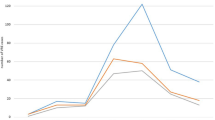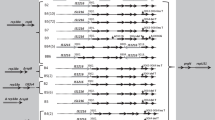Abstract
Although multilocus sequence typing (MLST) has been used to study molecular epidemiology and to explore the population structure of Enterococcus faecium, vancomycin-resistant E. faecium (VREF) strains lacking the pstS gene that were non-typable using conventional MLST methods were reported recently. We found nationwide emergence of VREF isolates lacking pstS in Korea and hereby report the molecular characteristics of these isolates. Forty-six VREF isolates lacking the pstS gene were identified among 300 VREF rectal isolates collected from hospitalized patients between 2014 and 2015. MLST was performed and clonal relatedness was determined by pulsed-field gel electrophoresis (PFGE). Four VREF ST1421 isolates were whole-genome sequenced. Among the VREF rectal isolates lacking pstS, 98% were classified as ST1421, which has identical allelic profiles to ST17 for all housekeeping genes except pstS. PFGE pattern analyses revealed 32 pulsotypes. All isolates harbored Tn1546 components with various transposase and insertion sequences. The whole-genome sequencing of four VREF ST1421 isolates showed that the pstS gene region was deleted at various locations with considerable inversion. The pstS gene was also depleted in 12.1% of 33 VREF clinical isolates in 2006–2007 and in 11.8% of 59 clinical isolates in 2012–2013. VREF ST1421 strains lacking the pstS gene have emerged in Korea. The emergence and spread of pstS-deleted VREF strains pose a serious challenge for epidemiological investigation. Alternative molecular typing methods to MLST will be increasingly necessary.





Similar content being viewed by others
References
de Been M, Pinholt M, Top J, Bletz S, Mellmann A, van Schaik W, Brouwer E, Rogers M, Kraat Y, Bonten M, Corander J, Westh H, Harmsen D, Willems RJ (2015) Core genome multilocus sequence typing scheme for high-resolution typing of Enterococcus faecium. J Clin Microbiol 53(12):3788–3797
Raven KE, Reuter S, Reynolds R, Brodrick HJ, Russell JE, Torok ME, Parkhill J, Peacock SJ (2016) A decade of genomic history for healthcare-associated Enterococcus faecium in the United Kingdom and Ireland. Genome Res 26(10):1388–1396
Carter GP, Buultjens AH, Ballard SA, Baines SL, Tomita T, Strachan J, Johnson PD, Ferguson JK, Seemann T, Stinear TP, Howden BP (2016) Emergence of endemic MLST non-typeable vancomycin-resistant Enterococcus faecium. J Antimicrob Chemother 71(12):3367–3371
Lemonidis K, Salih TS, Dancer SJ, Hunter IS, Tucker NP (2019) Emergence of an Australian-like pstS-null vancomycin resistant Enterococcus faecium clone in Scotland. PLoS One 14(6):e0218185. https://doi.org/10.1371/journal.pone.0218185
Hansen TA, Pedersen MS, Nielsen LG, Ma CMG, Soes LM, Worning P, Ostergaard C, Westh H, Pinholt M, Schonning K (2018) Emergence of a vancomycin-variable Enterococcus faecium ST1421 strain containing a deletion in vanX. J Antimicrob Chemother 73(11):2936–2940
Depardieu F, Perichon B, Courvalin P (2004) Detection of the van alphabet and identification of enterococci and staphylococci at the species level by multiplex PCR. J Clin Microbiol 42(12):5857–5860
Vankerckhoven V, Van Autgaerden T, Vael C, Lammens C, Chapelle S, Rossi R, Jabes D, Goossens H (2004) Development of a multiplex PCR for the detection of asa1, gelE, cylA, esp, and hyl genes in enterococci and survey for virulence determinants among European hospital isolates of Enterococcus faecium. J Clin Microbiol 42(10):4473–4479
Darling AC, Mau B, Blattner FR, Perna NT (2004) Mauve: multiple alignment of conserved genomic sequence with rearrangements. Genome Res 14(7):1394–1403
Alikhan NF, Petty NK, Ben Zakour NL, Beatson SA (2011) BLAST ring image generator (BRIG): simple prokaryote genome comparisons. BMC Genomics 12:402
Chaudhari NM, Gupta VK, Dutta C (2016) BPGA-an ultra-fast pan-genome analysis pipeline. Sci Rep 6:24373
Jones DT, Taylor WR, Thornton JM (1992) The rapid generation of mutation data matrices from protein sequences. Comput Appl Biosci 8(3):275–282
Son JS, Song JH, Ko KS, Yeom JS, Ki HK, Kim SW, Chang HH, Ryu SY, Kim YS, Jung SI, Shin SY, Oh HB, Lee YS, Chung DR, Lee NY, Peck KR (2010) Bloodstream infections and clinical significance of healthcare-associated bacteremia: a multicenter surveillance study in Korean hospitals. J Korean Med Sci 25:992–998
Chung DR (2014) Antimicrobial resistance and molecular epidemiology of major pathogens isolated from patients with bacteremia and urinary tract infection. Report by Korea Centers for Disease Control and Prevention
Willems RJ, Top J, van Santen M, Robinson DA, Coque TM, Baquero F, Grundmann H, Bonten MJ (2005) Global spread of vancomycin-resistant Enterococcus faecium from distinct nosocomial genetic complex. Emerg Infect Dis 11(6):821–828
van Hal SJ, Ip CL, Ansari MA, Wilson DJ, Espedido BA, Jensen SO, Bowden R (2016) Evolutionary dynamics of Enterococcus faecium reveals complex genomic relationships between isolates with independent emergence of vancomycin resistance. Microb Genom 2(1). https://doi.org/10.1099/mgen.0.000048
Kim J, Kwon YI, Lee WG (2017) Comparison of multilocus sequence typing change patterns of vancomycin-resistant Enterococcus faecium from 2015 to 2017. Ann Clin Microbiol 20(3):67–73
Bertini A, Poirel L, Bernabeu S, Fortini D, Villa L, Nordmann P, Carattoli A (2007) Multicopy blaOXA-58 gene as a source of high-level resistance to carbapenems in Acinetobacter baumannii. Antimicrob Agents Chemother 51(7):2324–2328
Funding
This research was supported by a grant from the Korea Health Technology R&D Project through the Korea Health Industry Development Institute (KHIDI), funded by the Ministry of Health & Welfare, Republic of Korea (Government-wide R&D Fund Project for infectious disease research, HG18C0062) and the Bio & Medical Technology Development Program of the National Research Foundation (NRF) funded by the Ministry of Science & ICT (NRF-2016M3A9B6919187).
Author information
Authors and Affiliations
Corresponding author
Ethics declarations
Conflict of interest
The authors declare that they have no conflict of interest.
Ethical approval
Rectal swab surveillance for VREF and collection of bacterial isolates were approved by the Infection Control Committee of the Samsung Medical Center. Collection of VREF blood isolates was approved by the Institutional Review Board of the Samsung Medical Center.
Additional information
Publisher’s note
Springer Nature remains neutral with regard to jurisdictional claims in published maps and institutional affiliations.
Rights and permissions
About this article
Cite this article
Kim, H.M., Chung, D.R., Cho, S.Y. et al. Emergence of vancomycin-resistant Enterococcus faecium ST1421 lacking the pstS gene in Korea. Eur J Clin Microbiol Infect Dis 39, 1349–1356 (2020). https://doi.org/10.1007/s10096-020-03853-4
Received:
Accepted:
Published:
Issue Date:
DOI: https://doi.org/10.1007/s10096-020-03853-4




